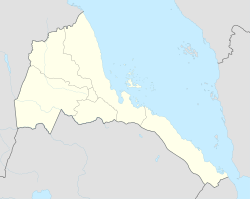Eritrea has an estimated population of 4,954,645 as of 2016. No reliable census data is available, the best available estimates being published by the Population Division of the United Nations Department of Economic and Social Affairs. The population has doubled over the past 30 years, with an accelerating growth rate estimated at close to 3.2% p.a. during 2005–2010. This rate of population growth is sustained despite a high emigration rate; the World Bank as of 2010 estimated that close to a million of Eritreans have emigrated.

Asmara or Asmera is the capital and most populous city of Eritrea, in the country's Central Region. It sits at an elevation of 2,325 metres (7,628 ft), making it the sixth highest capital in the world by altitude. The city is located at the tip of an escarpment that is both the northwestern edge of the Eritrean highlands and the Great Rift Valley in neighbouring Ethiopia. In 2017, the city was declared as a UNESCO World Heritage Site for its well-preserved modernist architecture. Asmara was first settled in 800 BC with a population ranging from 100 to 1000. The city was then founded in the 12th century CE after four separate villages unified to live together peacefully after long periods of conflict.
The Eritrean–Ethiopian War, one of the conflicts in the Horn of Africa, took place between Ethiopia and Eritrea from May 1998 to June 2000, with the final peace only agreed to in 2018, twenty years after the initial confrontation. Eritrea and Ethiopia, two of the world's poorest countries, spent hundreds of millions of dollars on the war and suffered tens of thousands of casualties as a direct consequence of the conflict. Only minor border changes resulted.

Eritrean cuisine is a fusion of Eritrea's native culinary traditions, arising from social interchanges with other regions. The local cuisine shares similarities with those of other countries in the Horn of Africa and Nile Valley, including Djibouti, Ethiopia, Somalia and Sudan.

The Eritrean War of Independence was a conflict fought between the Ethiopian government and Eritrean separatists from September 1961 to May 1991.
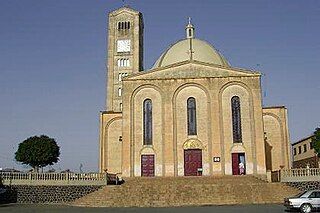
The Eritrean Catholic Church is a Metropolitan sui iuris Eastern particular church headquartered in Asmara, Eritrea. Established in 2015 by separation from the Ethiopian Catholic Church, it is in full communion with the Holy See. It follows the Alexandrian liturgical rite.
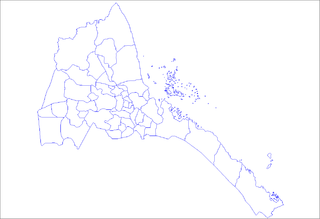
The six regions of Eritrea are divided into administrative subregions.
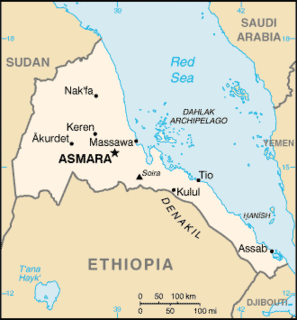
The Eritrean Civil Wars were two conflicts that were fought between competing organizations for the liberation of Eritrea.

Hambok is a village in western Eritrea. It is located in Gogne District in the Gash-Barka region.
Gogne Subregion is a subregion in the western Gash-Barka region of Eritrea. Its capital lies at Gogne.

Markaughe is a town in western Eritrea. It is located in the Gogne subregion of the Gash-Barka region, approximately 35 km northwest of Barentu.

Ad Casub is a village in western Eritrea. It is located in Gogne District in the Gash-Barka region.

Tauda is a town in western Eritrea.
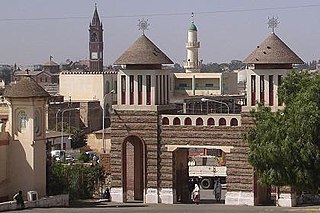
Religion in Eritrea mainly consists of Abrahamic faiths. Since May 2002, the Eritrean government has officially recognized the Eritrean Orthodox Tewahedo Church, the Eritrean Catholic Church, the Evangelical Lutheran Church of Eritrea, and Sunni Islam. All other faiths and denominations are in principle required to undergo a registration process; in practice they are not allowed to register. Among other things, the government's registration system requires religious groups to submit personal information on their membership to be allowed to worship.

Gagoré is a town in southern Ivory Coast. It is a sub-prefecture of Lakota Department in Lôh-Djiboua Region, Gôh-Djiboua District.

Italian Eritrea was a colony of the Kingdom of Italy in the territory of present-day Eritrea. Although it was formally created in 1890, the first Italian settlements in the area were established in 1882 around Assab. The colony officially lasted until 1947.
Eritrean Americans are Americans who are of Eritrean ancestry. As of 2013, there are 33,930 Eritrean-born citizens living in the U.S.

The Battle of Halhal was a battle of the Eritrean War of Independence, and took place on 18 July 1962. In the battle, the Eritrean Liberation Front was able to overrun the local police office in Halhal and control it for an entire day. The defenders, which were Eritrean Police commandos, had been trained by the Israeli military.



